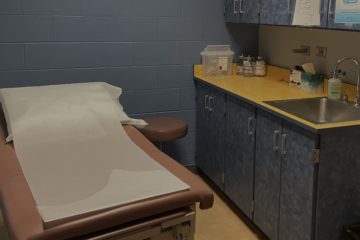by Amelia Ferrel Knisely
Employees at Clay County High School spent this holiday season talking to students about the importance of gift giving and thankfulness.
“Our library looks like a Walmart right now,” said Leslie Osburn, a school counselor. “They learn joy, gratitude and the effort that goes into [gift giving].”
It wasn’t a typical part of the curriculum, but women in the school system said their work included helping kids thrive beyond the walls of the school.


Clay is the second poorest county in the state, only behind McDowell County, and its isolated location is short of jobs, restaurants and fresh food. Internet access is spotty.
Many kids in the county don’t live with their biological parents, and state education data shows around one in three students in the county experience homelessness, often lacking a permanent place to sleep.
The county has been impacted by the state’s poverty and drug epidemic, so kids regularly need food and clothes, school employees said.
Osburn said her students often feel inferior to other kids around the state.
“A lot of it is because of geographical location, and a lot of it is the people they’re living with don’t have the means to get them where they need to go,” she said.
School employees have added lessons about how to access a birth certificate, navigate the Division of Motor Vehicles and prepare for the workforce.
“Instead of spending my energy trying to convince someone to drive from Charleston, I just think, ‘What can I do here … what can I teach?’” said Kelly Duffield, a school psychologist in the county.

Kelly Duffield
She operates a successful vaping intervention program but money is running out.
“We’re trying to sustain our funding,” Duffield said.
The programs and people who are helping kids in Clay County face financial challenges as the county is set to receive an undetermined amount from the $1 billion in opioid settlement funds. The money follows years of legal battles with opioid manufacturers and distributors over the last few years for their role in the state’s drug epidemic.
While Clay County is guaranteed to receive some settlement money, women who work with local children and families fear the historical cash infusion will largely bypass their small, rural county. They also worried that a nonprofit overseeing the bulk of the funds distribution will invest in pilot programs or virtual services – things that look good on paper but won’t work in a county that struggles with internet access and transportation.
“I think we have people in this county with really good solutions,” Duffield said. “If we can get money in the hands of people who care …they’re going to find solutions to problems. We’re dealing with complicated solutions.”
She added, “Just money isn’t going to do anything.”
Mental health, employment are top county needs
The Clay County Health Department, located in downtown Clay, is a central location for many residents’ needs. Its employees regularly help those struggling with poverty alongside providing vaccinations, women’s health care and more.
They also respond to the area’s substance abuse crisis. Two days a week, a bus sets up in the department’s parking lot to offer help to those in need.
“I see a sense of despair among people struggling with substance use disorder in our county,” said Angela Brown, a nurse practitioner at the county health department.
Substance abuse treatment beds aren’t nearby, she said, making it especially hard for Clay residents without cars to get the help they need. Jones estimated the nearest substance abuse treatment facility was 30-40 min. away. Around the state, there are limited treatment options for children struggling with substance abuse.
Clay residents regularly struggle with transportation, Jones noted.
“If they had a place to go when they’re ready to get treatment – not just a pamphlet, essentially,” she said.
Jones said that because of the lack of mental health care in the county, the school system is one of the main care providers in the county – regularly serving kids who are impacted by the opioid crisis.
“Their demand is much greater than the resources they have available,” she said. “We have generational [drug] use at this point … People are trying to cope with something they don’t know how to cope with.”
Duffield said that the school system does a good job of helping kids when “they’re in the building,” but outside of school hours, it’s a challenge to help kids and families in crisis.
Nationwide, pediatric mental health is in crisis following the Covid-19 pandemic. In West Virginia, there are “alarmingly high” wait times for mental health care, leading more kids to emergency rooms for care, which aren’t intended to help children in psychiatric distress.
“When we have families in crisis, no, we don’t have adequate support. We don’t have in-person mobile crisis support,” Duffield said.
Local governments will have the final say on how to spend the county’s opioid settlement funds, which were expected to start flowing in by the end of the year.
As the county awaits its funds, the women interviewed for this story had a clear vision for how it should be spent: local, in-person mental health care.
“Service may say they serve Clay, but that doesn’t necessarily mean we are helped by the program,” Duffield said. “In order for the services to reach our people, they need to be delivered by the people invested in our community.”
She hoped that the funds could be used to continue programs already working – like her youth vaping intervention program – instead of reinventing the wheel with the money.
Jones wanted to see local substance abuse treatment. Osburn noted a need for infrastructure improvements, like jobs and the internet.
“We’ve seen millions of dollars coming into [West Virginia] for the internet, but we never see it,” she said.
The First Foundation, the nonprofit overseeing the distribution of the bulk of the settlement money, is expected to receive around $217 million from the settlement this year. The money will continue to flow to the state at least through 2036.
The money must be used to address the opioid crisis, including addiction treatment, prevention programs, law enforcement and more.
Duffield stressed that her community was resilient, and they’re not waiting for money to help those affected by the drug crisis – especially the children.
Osburn proudly added that they regularly get compliments on their students’ behavior.
“I attribute that to caring relationships,” she said. “Staff and community members constantly go above and beyond to meet the needs of kids.”

Amelia Ferrell Knisely is an award-winning journalist with West Virginia Watch, a nonprofit newsroom. Originally from Rand, West Virginia, she has previously written for Mountain State Spotlight and the Charleston Gazette-Mail about child welfare, hunger and poverty. Ferrell Knisely also previously worked for The Tennessean in Nashville. Follow her on Twitter.



2 Comments
Phillena Frame · January 4, 2024 at 3:22 pm
Good Morning,
I love the article! However, could you please correct the name of the Clay County Health Department employee to Angela Brown in the article. She is Angela Brown, FNP-C that works at the Clay County Health Department. Not Angela Jones. Thanks so much!
Think Kids · February 4, 2024 at 5:42 am
Thanks for the correction, Phillena! Apologies that it took so long for us to see your post. We’ve made the correction.